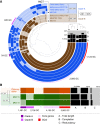Transcriptome reconstruction and functional analysis of eukaryotic marine plankton communities via high-throughput metagenomics and metatranscriptomics
- PMID: 32205368
- PMCID: PMC7197479
- DOI: 10.1101/gr.253070.119
Transcriptome reconstruction and functional analysis of eukaryotic marine plankton communities via high-throughput metagenomics and metatranscriptomics
Abstract
Large-scale metagenomic and metatranscriptomic data analyses are often restricted by their gene-centric approach, limiting the ability to understand organismal and community biology. De novo assembly of large and mosaic eukaryotic genomes from complex meta-omics data remains a challenging task, especially in comparison with more straightforward bacterial and archaeal systems. Here, we use a transcriptome reconstruction method based on clustering co-abundant genes across a series of metagenomic samples. We investigated the co-abundance patterns of ∼37 million eukaryotic unigenes across 365 metagenomic samples collected during the Tara Oceans expeditions to assess the diversity and functional profiles of marine plankton. We identified ∼12,000 co-abundant gene groups (CAGs), encompassing ∼7 million unigenes, including 924 metagenomics-based transcriptomes (MGTs, CAGs larger than 500 unigenes). We demonstrated the biological validity of the MGT collection by comparing individual MGTs with available references. We identified several key eukaryotic organisms involved in dimethylsulfoniopropionate (DMSP) biosynthesis and catabolism in different oceanic provinces, thus demonstrating the potential of the MGT collection to provide functional insights on eukaryotic plankton. We established the ability of the MGT approach to capture interspecies associations through the analysis of a nitrogen-fixing haptophyte-cyanobacterial symbiotic association. This MGT collection provides a valuable resource for analyses of eukaryotic plankton in the open ocean by giving access to the genomic content and functional potential of many ecologically relevant eukaryotic species.
© 2020 Vorobev et al.; Published by Cold Spring Harbor Laboratory Press.
Figures





Similar articles
-
Eukaryotic genomes from a global metagenomic data set illuminate trophic modes and biogeography of ocean plankton.mBio. 2023 Dec 19;14(6):e0167623. doi: 10.1128/mbio.01676-23. Epub 2023 Nov 10. mBio. 2023. PMID: 37947402 Free PMC article.
-
A global ocean atlas of eukaryotic genes.Nat Commun. 2018 Jan 25;9(1):373. doi: 10.1038/s41467-017-02342-1. Nat Commun. 2018. PMID: 29371626 Free PMC article.
-
Ocean plankton. Eukaryotic plankton diversity in the sunlit ocean.Science. 2015 May 22;348(6237):1261605. doi: 10.1126/science.1261605. Science. 2015. PMID: 25999516
-
Eukaryotic picoplankton in surface oceans.Annu Rev Microbiol. 2011;65:91-110. doi: 10.1146/annurev-micro-090110-102903. Annu Rev Microbiol. 2011. PMID: 21639789 Review.
-
Metatranscriptomics: A Tool for Clinical Metagenomics.OMICS. 2024 Aug;28(8):394-407. doi: 10.1089/omi.2024.0130. Epub 2024 Jul 19. OMICS. 2024. PMID: 39029911 Review.
Cited by
-
Holistic view of the seascape dynamics and environment impact on macro-scale genetic connectivity of marine plankton populations.BMC Ecol Evol. 2023 Sep 1;23(1):46. doi: 10.1186/s12862-023-02160-8. BMC Ecol Evol. 2023. PMID: 37658324 Free PMC article.
-
SEQ2MGS: an effective tool for generating realistic artificial metagenomes from the existing sequencing data.NAR Genom Bioinform. 2022 Jul 25;4(3):lqac050. doi: 10.1093/nargab/lqac050. eCollection 2022 Sep. NAR Genom Bioinform. 2022. PMID: 35899079 Free PMC article.
-
Genomic differentiation of three pico-phytoplankton species in the Mediterranean Sea.Environ Microbiol. 2022 Dec;24(12):6086-6099. doi: 10.1111/1462-2920.16171. Epub 2022 Aug 24. Environ Microbiol. 2022. PMID: 36053818 Free PMC article.
-
A Novel Group of Dynamin-Related Proteins Shared by Eukaryotes and Giant Viruses Is Able to Remodel Mitochondria From Within the Matrix.Mol Biol Evol. 2023 Jun 1;40(6):msad134. doi: 10.1093/molbev/msad134. Mol Biol Evol. 2023. PMID: 37279941 Free PMC article.
-
Unifying the known and unknown microbial coding sequence space.Elife. 2022 Mar 31;11:e67667. doi: 10.7554/eLife.67667. Elife. 2022. PMID: 35356891 Free PMC article.
References
-
- Armbrecht LH, Eriksen R, Leventer A, Armand LK. 2017. First observations of living sea-ice diatom agglomeration to tintinnid loricae in East Antarctica. J Plankton Res 39: 795–802. 10.1093/plankt/fbx036 - DOI
-
- Ayers GP, Cainey JM. 2007. The CLAW hypothesis: a review of the major developments. Environ Chem 4: 366–374. 10.1071/EN07080 - DOI
Publication types
MeSH terms
LinkOut - more resources
Full Text Sources
